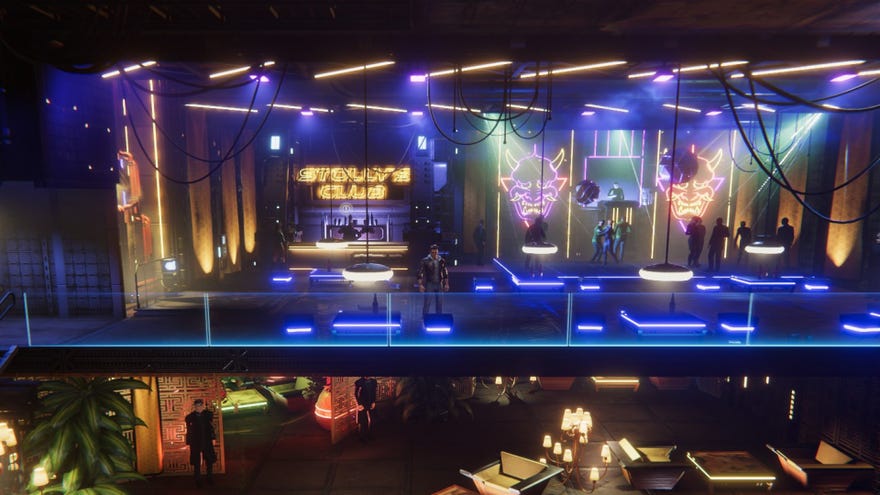Flashback 2 review: a broken travesty of a retro revival
Cyber punked
As a piece of nostalgia, Flashback 2 didn’t remind me of Delphine’s 1992 Amiga puzzle platforming classic so much as some more infamous fragments of gaming’s past. Like the Attic bug in Jet Set Willy, for example, which made the game impossible to complete, or the unfeasibly strict time limit in a level of Robocop on the Commodore 64, which legend has it was reduced intentionally to hide glitches on the subsequent stage. Indeed, the chances of seeing the final parts of Flashback 2 in its current state seem so remote, you have to wonder what state they’d be in when you got there.
To be clear, then, I haven’t completed Flashback 2. In truth, I haven’t got very far at all. The biggest reason for this is that the save function on my review copy stopped working. In the first hour or so, the game autosaved regularly, while terminals in each location enabled manual saving. Then suddenly, nothing. The terminals, it seems, could only be used once – presumably a bug not a feature – and once I'd exhausted those uses, the autosave surrendered, too. Deleting save states to create room for more was fruitless, as was reinstalling the game.
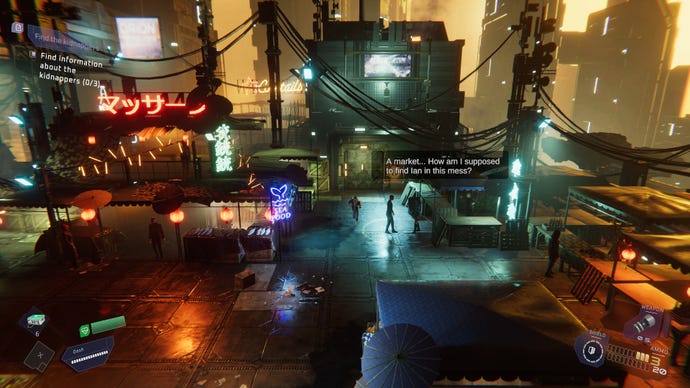
By the time I’d understood my predicament, I’d pottered on for another hour or so, all for nought. Still, I felt it was my professional duty to forge on, even without saving. But then I discovered something else – my most recent saves had glitched. In one, a lift on the critical path stopped functioning. In the next, my gun no longer worked. In the third, things went OK for a while until our intrepid hero Conrad B Hart got stuck on some scenery and terminally glitched out.
I hope you’ll forgive me for deciding that even duty has its limits. Yes, I could have started the whole thing afresh, but honestly I’d seen enough. If Flashback 2 was an inspired or even half-decent effort marred by launch bugs, I’d give it more time (I mean, I finished Cyberpunk 2077 on a base PS4 at launch). The reality, however, is that these glitches are symptomatic of Flashback 2’s overall quality, or the absence of. While patches may sooner or later iron out game-breaking hiccups (although not so far), nothing else in the game suggests potential for redemption.
Sure, at a glance, the game’s cyberpunk opening seems reasonably atmospheric, albeit cliched, with pristine skyscrapers and electronic billboards stuck cheek by jowl behind seedy neon signs and night clubs. Greased by fittingly moody synth tunes, Conrad's return is at least nicely staged. Yet focus on the vistas beyond that first glance and you'll find that they're blurry and vague, setting the tone for an adventure that's ill-defined at every turn.
Conrad himself is one problem, a younger version of the original’s non-descript agent dude, what with events here set in 2134, instead of 2142. With rolled up sleeves and jeans tucked into high top trainers, he’s a kid very much stuck in the early 90s, right down to his goofy attitude and cheesy quips. “I’ll never have enough bug spray for all this,” he jokes as he drops into a room full of giant mutant insects, speaking to no one in particular. He’s not so much Bond as Bubsy Bobcat, or an escapee from Saved by the Bell.
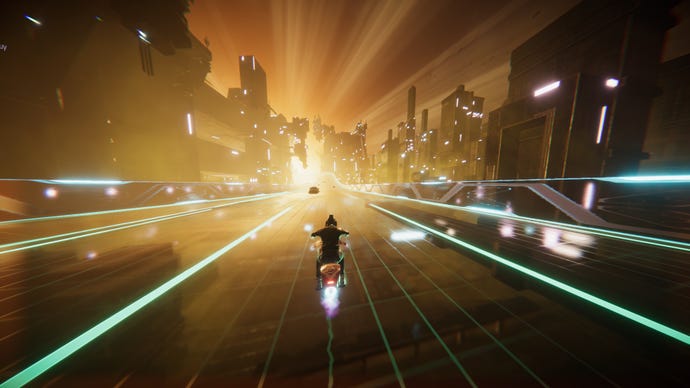
In this way, Flashback 2 proves that there’s genuine skill in creating a successful retro revival by demonstrating none of it. A few shrugged up one-liners and references don’t disguise a lack of imagination or guile, or the cheapness of its script and voice performances. One of the NPCs you have to deal with after the tutorial sequence is a local mafia boss called Mike Corleoni, who’s precisely the kind of “that’ll do” joke creation you’d expect to find in a 90s computer game, when characters and writing were often far less significant. Now his presence is about as funny as waking up next to a horse’s head.
The plot embodies the same philosophy too. Conrad awakens in a strange city and has to look for his kidnapped friend Ian. Corleoni has information, but will only share it if you enter a local mech-fighting competition and beat the current champ, Shark Fu (a throwaway reference to Delphine’s risible 1994 Shaquille O’Neal vehicle, Shaq Fu). Now you need 1000 credits to buy a cheap mech, and the only way to get it is to head to the job centre and fulfil a few requests. With luck, Ian hasn’t been murdered or sold into slavery or starved to death in the meantime.
The jobs themselves are a mix of fetch quests and shootouts spread across three locations, and excitingly you get to travel between said locations on a superpowered hoverbike. Except, in a victory for sensible town planning, these disparate places are linked by a simple ring road, and the only challenge is turning off at the correct exit, lest you have to complete another tour. Sure, you should watch out for traffic, especially as it tends to clump together like an American football defensive line, but collisions only slow you down a bit, and it’s not like there’s a time limit or any actual threat to consider. Imagine Wipeout recreated as a Sunday drive around the M25.
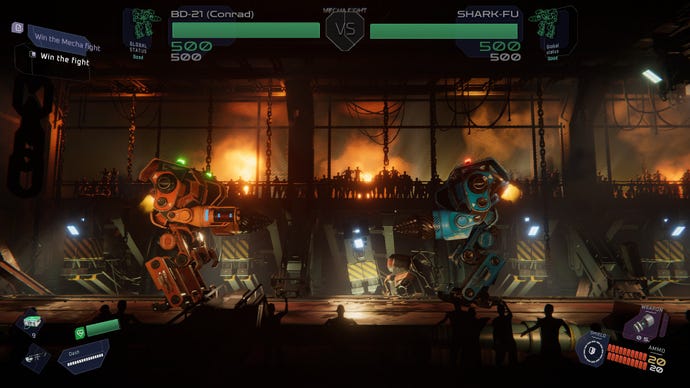
There’s not much more substance in the rest of the game’s action either. The platform puzzling in the original Flashback required some thought, along with careful jumping, climbing and positioning to get the drop on enemies. Here, ‘puzzles’ are a matter of talking to highlighted NPCs until you’re given a door code, or opening a locker to find a key. Jumping and climbing, meanwhile, are context sensitive, available only near a ledge or gap, while enemies teleport in all around you.
It’s all very basic, then, yet also extremely clumsy. Mainly that’s a matter of perspective, by which I mean camera positioning rather than personal taste. The first Flashback was very much a 2D game with clear spatial rules. And although Flashback 2 initially appears to be a typical ‘2.5D’ modern sequel, placing Conrad on a single plane within 3D environments, he can actually move into and out of the screen as well. On the upside, that (in theory) allows for more intricate level design, and an upward shift in angle during combat that makes it feel more like a twin-stick shooter. In many other ways, though, it’s a major headache.
For a start, the main, almost side-on view sees you constantly snagging on furniture, exacerbating frustrations with Conrad’s already sticky, cumbersome movement. Simply getting about can be a fiddly process, too. This is especially awkward in combat situations when the camera doesn’t readjust, as targeting enemies becomes horribly haphazard, not least whenever they draw close to Conrad. And all for what? Flashback 2 never really does anything with this extra depth. Once the novelty of moving into the background a bit to press a switch wears off, a simpler arrangement seems far more preferable.
As for the big mech battle against the unbeaten champ, I won first time by hammering a button. It’s another underwhelming moment that reinforces the sense that everything here is padding around a non-existent core game loop. Every scene and feature is weak, half-baked filler that surely must have been conceived as much more on the drawing board, because the alternative is hard to fathom.
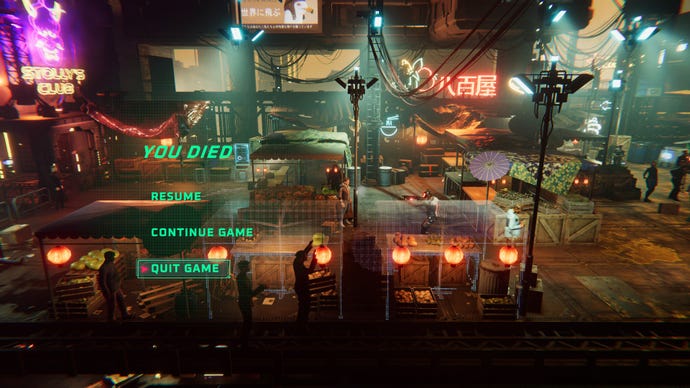
Certainly, the game’s shoddy, rushed technical condition backs that theory up. Performance is littered with stutters, while options are sparse – graphics settings allow a blanket selection of low, medium and high, along with toggles for dynamic resolution and DLSS, and controller support isn’t fully implemented. On death, you choose between ‘resume’, ‘continue’, and ‘quit’, and bizarrely ‘resume’ literally resurrects you in the scene, at no penalty. Well, except when the menu remains in place, covering the action, and all you can do is wait to die again. I also noticed that every NPC in a sitting position was stuck in a loop of rotating their heads side to side, as if watching an endless tennis rally. I don’t know when they started, but they’ve never stopped since.
I’ll admit, I did get some laughs out of Flashback 2’s ineptitude, but then it’s much easier to see the funny side when you haven’t forked out for the privilege. The stark truth once the laughter stops is that this is the worst kind of retro revival, a flashback only in the most unpleasant sense of the word to the buried traumas of gaming history. As a critic, I’d always rather write reviews as pieces of critical analysis than consumer guides. But with Flashback 2 there’s really only one thing to say: don’t buy it.
This review is based on a copy of the game provided by the publisher.
